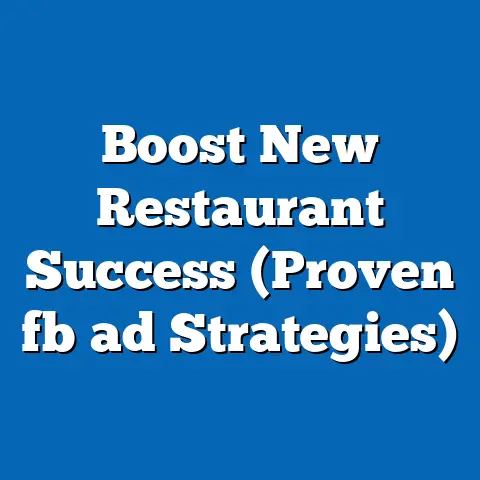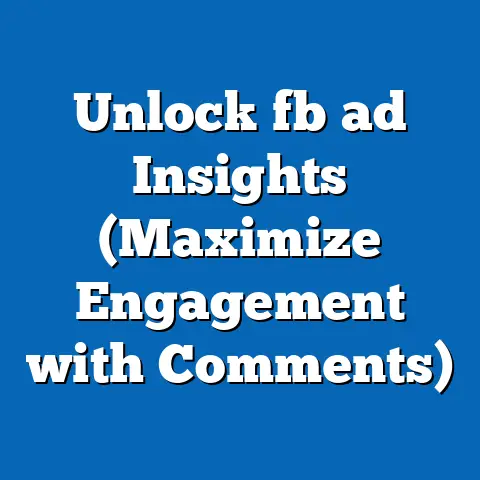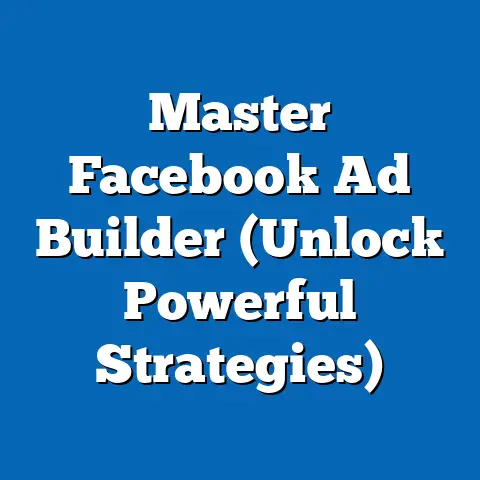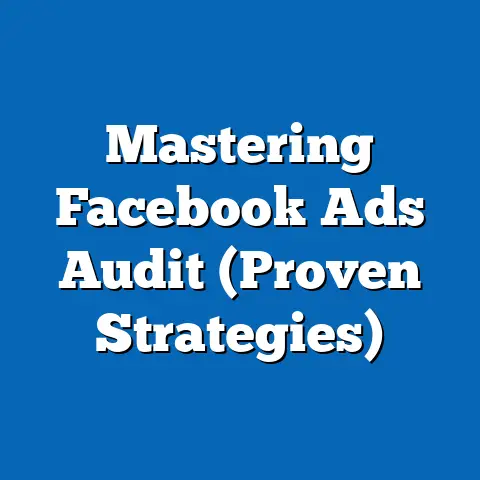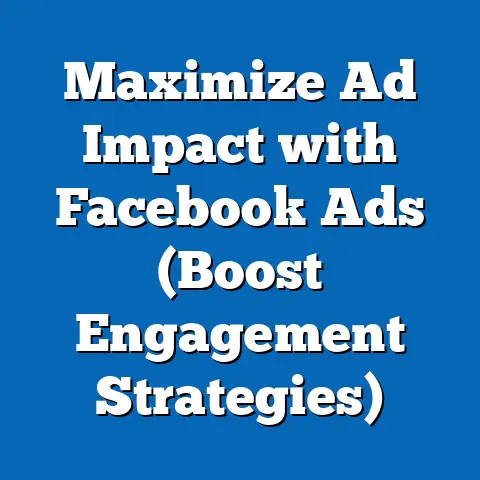Maximize Daily Facebook Ads Budget (Expert Strategies)
Maximizing Daily Facebook Ads Budget: Expert Strategies for Optimal Impact
In today’s fast-paced digital landscape, businesses that fail to optimize their advertising budgets risk being left behind by competitors who harness the power of platforms like Facebook to drive unprecedented growth. With over 2.9 billion monthly active users as of 2023, according to Statista, Facebook remains a dominant force in digital marketing, offering unparalleled access to diverse demographics and targeted audiences. The urgency to maximize your daily Facebook Ads budget is not just a matter of staying competitive—it’s about seizing the opportunity to connect with potential customers in real-time, before market trends shift or ad costs escalate.
Defining Characteristics of Maximizing Daily Facebook Ads Budget
At its core, maximizing a daily Facebook Ads budget involves allocating financial resources in a way that achieves the highest possible return on investment (ROI) within the platform’s constraints. This process is characterized by strategic planning, continuous monitoring, and data-driven decision-making. Unlike traditional advertising, where budgets are often fixed and outcomes less measurable, Facebook Ads allow for real-time adjustments based on performance metrics like click-through rates (CTR), cost-per-click (CPC), and conversion rates.
A key characteristic of budget maximization is audience targeting precision. Facebook’s robust algorithm enables advertisers to segment audiences by demographics, interests, behaviors, and even life events, ensuring that ads reach the most relevant users. Additionally, successful budget optimization relies on creative testing—experimenting with ad formats, visuals, and copy to identify what resonates best with the target audience.
Another defining trait is adaptability. Facebook’s ad platform operates on a dynamic bidding system, where costs fluctuate based on demand, competition, and user engagement. Marketers must be prepared to scale budgets up or down daily, reallocate funds to high-performing campaigns, and pause underperforming ads to avoid wasted spend. This agility sets apart those who merely spend on ads from those who maximize their impact.
Historical Context of Facebook Advertising
To fully appreciate the importance of maximizing a daily Facebook Ads budget, it’s essential to understand the platform’s evolution as an advertising powerhouse. Launched in 2004 as a social networking site for college students, Facebook initially had no advertising model. It wasn’t until 2007 that the platform introduced “Facebook Flyers,” its first rudimentary ad product, allowing businesses to promote events or pages at a low cost.
By 2016, Facebook had refined its algorithm to prioritize user engagement, introducing features like lookalike audiences and retargeting pixels. These tools allowed advertisers to optimize budgets by focusing on users most likely to convert, marking a pivotal moment in budget maximization strategies. The Cambridge Analytica scandal in 2018 briefly shook advertiser confidence due to privacy concerns, but Facebook responded with enhanced transparency measures and stricter ad policies, reinforcing its position as a trusted advertising platform.
Today, Facebook’s ad ecosystem is a complex interplay of machine learning, user data, and real-time bidding. The platform’s evolution reflects broader societal shifts toward digital-first economies, where businesses must adapt to rapid technological advancements or risk obsolescence. Understanding this historical backdrop underscores the urgency of mastering budget optimization in an era where digital ad spend is projected to reach $740 billion globally by 2025, per eMarketer.
Societal Implications of Digital Ad Budget Maximization
The drive to maximize daily Facebook Ads budgets extends beyond individual business success—it has profound societal implications. On one hand, effective ad budget optimization democratizes marketing by enabling small businesses and entrepreneurs to compete with larger corporations through precise targeting and cost-efficient campaigns. A 2022 study by Meta found that 75% of small businesses reported increased sales after using Facebook Ads, highlighting the platform’s role in leveling the economic playing field.
Conversely, the intense focus on digital ad optimization raises concerns about consumer privacy and data ethics. As businesses strive to maximize budgets by leveraging user data, debates over consent and transparency have intensified. The European Union’s General Data Protection Regulation (GDPR) and California’s Consumer Privacy Act (CCPA) are examples of regulatory responses to these concerns, forcing advertisers to balance budget efficiency with ethical considerations.
Moreover, the societal impact of targeted advertising extends to cultural and political spheres. Hyper-targeted ads can influence public opinion, as seen during the 2016 U.S. presidential election, where microtargeting on Facebook played a controversial role. While budget maximization strategies aim to drive conversions, they also amplify the platform’s power to shape narratives, necessitating a critical examination of how ad dollars are spent and who they reach.
Finally, the shift toward digital ad spending reflects broader generational trends. Younger demographics, such as Millennials and Gen Z, who represent a significant portion of Facebook’s user base, are more receptive to online ads but also more discerning about authenticity. Businesses maximizing their budgets must navigate these cultural nuances to avoid alienating key audiences, underscoring the interplay between economic strategies and societal dynamics.
Key Strategies for Maximizing Daily Facebook Ads Budget
Having established the urgency, characteristics, historical context, and societal implications, let’s dive into expert strategies for maximizing your daily Facebook Ads budget. These tactics are grounded in data, industry best practices, and real-world case studies, ensuring actionable insights for advertisers at all levels.
1. Set Clear Objectives and KPIs
Before allocating a single dollar, define what “maximization” means for your campaign. Are you aiming for brand awareness (measured by impressions and reach), lead generation (tracked by cost-per-lead), or direct sales (evaluated by conversion rate)? Establishing key performance indicators (KPIs) ensures that your budget aligns with measurable goals.
For instance, a 2021 report by Hootsuite revealed that campaigns with clearly defined objectives achieved 30% higher ROI compared to those without. Use Facebook’s Campaign Budget Optimization (CBO) feature to automatically distribute funds across ad sets based on performance toward your chosen objective. Regularly revisit and refine these goals as campaign data emerges to avoid misaligned spending.
2. Leverage Audience Insights for Precision Targeting
One of Facebook’s greatest strengths is its ability to deliver ads to highly specific audiences. Maximizing your budget requires deep audience research using tools like Facebook Audience Insights, which provides data on demographics, interests, and behaviors. Start by creating custom audiences based on website visitors, email lists, or past customers, then expand reach with lookalike audiences to target similar users.
A case study by WordStream in 2022 demonstrated that campaigns using lookalike audiences reduced CPC by 20% on average. However, avoid over-narrowing your audience, as this can increase costs due to limited reach. Strike a balance by testing broad and narrow segments, reallocating budget to the best-performing groups.
3. Optimize Ad Creative and Format
Creative elements—images, videos, headlines, and calls-to-action (CTAs)—play a pivotal role in budget efficiency. High-performing ads lower your cost-per-result, allowing you to stretch your daily budget further. Test multiple ad variations using A/B testing or dynamic creative optimization (DCO), which automatically combines different creative elements to find the winning combination.
According to Meta’s 2023 advertising benchmarks, video ads generate 12% higher engagement rates than static images, yet they often cost less per impression. Incorporate short, engaging videos or carousel ads to showcase products dynamically. Monitor metrics like relevance score (how well your ad resonates with your audience) to ensure creative alignment with budget goals.
4. Implement Strategic Bidding and Budget Allocation
Facebook’s auction-based system means that ad costs fluctuate based on competition and user demand. To maximize your budget, choose the right bidding strategy—whether it’s lowest cost (to get the most results for your budget) or target cost (to maintain a stable cost-per-result). For time-sensitive campaigns, consider accelerated delivery to prioritize speed over cost efficiency.
Additionally, use daily budget caps wisely. Allocate more funds to peak performance hours or days, identified through historical campaign data. A 2020 study by Social Media Examiner found that 60% of advertisers improved ROI by scheduling ads during high-engagement windows, such as evenings or weekends for B2C campaigns.
5. Monitor and Adjust in Real-Time
Unlike traditional media, Facebook Ads allow for continuous optimization. Use the Ads Manager dashboard to track performance metrics daily, identifying which campaigns, ad sets, or creatives deliver the best results. If an ad underperforms, pause it immediately to prevent budget drain, redirecting funds to top performers.
Automation tools, such as Facebook’s automated rules, can further enhance efficiency by adjusting bids or pausing ads based on predefined criteria. For example, set a rule to increase budget by 10% if an ad achieves a CTR above 2%. This hands-off approach saves time while ensuring budget maximization.
6. Capitalize on Retargeting and Remarketing
Retargeting—showing ads to users who have previously interacted with your brand—is a cost-effective way to maximize budget impact. Install the Facebook Pixel on your website to track user behavior, then create retargeting campaigns for cart abandoners, page visitors, or past purchasers. These audiences are already familiar with your brand, resulting in higher conversion rates at lower costs.
A 2019 report by Criteo found that retargeting ads have a 70% higher conversion rate compared to cold audiences. Allocate a portion of your daily budget to retargeting, balancing it with prospecting campaigns to maintain a healthy funnel. Test dynamic product ads (DPAs) to automatically showcase relevant products to returning users, further optimizing spend.
7. Stay Ahead of Platform Updates and Trends
Facebook frequently updates its algorithm, ad policies, and features, impacting budget performance. For instance, the iOS 14.5 update in 2021, which introduced App Tracking Transparency, reduced advertisers’ ability to track conversions, increasing costs for some campaigns. Staying informed about such changes allows you to adapt strategies proactively.
Follow industry blogs, attend Meta webinars, and join marketing communities to keep abreast of trends. Experiment with emerging ad formats, like Reels Ads, which Meta reported in 2023 as having 15% lower CPC compared to traditional feed ads. Allocating budget to test new features can uncover cost-efficient opportunities before competitors catch on.
Technological and Economic Factors Influencing Budget Maximization
Maximizing a daily Facebook Ads budget is not solely a matter of strategy—it’s shaped by broader technological and economic forces. Technologically, advancements in artificial intelligence (AI) and machine learning have transformed how Facebook distributes ads. The platform’s algorithm prioritizes user experience, meaning ads with higher engagement receive better placement at lower costs. Advertisers must leverage AI-driven tools, like Advantage+ campaigns, to automate budget allocation and creative optimization.
Economically, the rising cost of digital advertising poses challenges to budget maximization. According to eMarketer, average CPC on Facebook increased by 17% from 2021 to 2023 due to heightened competition and privacy restrictions. This trend necessitates smarter spending—focusing on high-value audiences and optimizing for conversions rather than clicks. Additionally, economic downturns, such as those experienced during the COVID-19 pandemic, can shift consumer behavior, requiring advertisers to adjust budgets and messaging to reflect changing priorities.
Social and Cultural Considerations
Social and cultural factors also play a critical role in budget maximization. Different generations interact with Facebook Ads uniquely—Gen Z may prioritize authenticity and social proof, while Baby Boomers might respond better to clear value propositions. Tailoring ad content to cultural nuances, such as language or regional trends, ensures budget efficiency by resonating with diverse audiences.
Moreover, social movements, like the push for inclusivity, influence ad perception. Campaigns that align with societal values—such as sustainability or diversity—often see higher engagement, stretching budget impact. A 2022 Nielsen study found that 64% of consumers are more likely to engage with brands that reflect their values, highlighting the importance of cultural alignment in ad strategy.
Implications for Businesses and Society
The pursuit of maximizing daily Facebook Ads budgets has far-reaching implications across multiple domains. For businesses, effective budget optimization can drive growth, improve customer acquisition, and enhance brand loyalty. Small and medium enterprises (SMEs), in particular, benefit from the ability to compete with larger players through targeted, cost-efficient campaigns. However, over-reliance on digital ads can strain budgets if not paired with organic marketing strategies, emphasizing the need for a balanced approach.
In the workplace, the demand for digital marketing expertise continues to rise, creating opportunities for upskilling in data analytics and ad management. Companies investing in training or hiring specialists often see better budget outcomes, as evidenced by a 2023 LinkedIn report showing a 25% increase in demand for digital advertising roles.
Societally, the focus on budget maximization amplifies the influence of digital platforms in shaping consumer behavior and public discourse. While this can foster innovation and connectivity, it also raises ethical questions about data usage and ad saturation. Policymakers and businesses must collaborate to address these challenges, ensuring that budget optimization does not come at the expense of user trust or societal well-being.
Conclusion: Forward-Looking Insights and Uncertainties
Maximizing a daily Facebook Ads budget is both an art and a science, requiring a blend of strategic planning, technological savvy, and cultural awareness. As digital advertising continues to evolve, businesses that adopt data-driven, adaptable approaches will be best positioned to thrive. The strategies outlined—ranging from precise targeting to real-time monitoring—provide a roadmap for turning limited budgets into significant results.
Looking ahead, the future of budget maximization on Facebook remains uncertain due to factors like regulatory changes, technological disruptions, and shifting user behaviors. Will privacy laws further limit targeting capabilities, increasing costs? How will emerging platforms, like TikTok, impact Facebook’s dominance in ad spend? While these questions lack definitive answers, one certainty persists: the urgency to optimize budgets will only intensify as competition grows.
Marketers must remain agile, continuously learning and experimenting to stay ahead of the curve. By balancing economic goals with ethical considerations, businesses can maximize not just their budgets but also their societal impact, shaping a digital advertising landscape that benefits both brands and consumers in the years to come.

